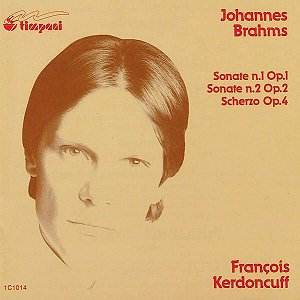 Composer: Johannes Brahms
Composer: Johannes Brahms
Works: Sonata in C major, Opus 1; Sonata in F sharp minor, Opus 2; Scherzo, Opus 4
Performers: François Kerdoncuff (piano)
Recording: November 1991, April 1992, Salle Adyar, Paris
Label: Timpani
Johannes Brahms, a towering figure in the Romantic canon, composed only three piano sonatas throughout his career, with the last being Opus 5. This relative scarcity heightens the significance of his sonatas, which serve as a comprehensive exploration of his evolving compositional voice. The present Timpani release features Kerdoncuff’s interpretations of Brahms’s early sonatas, providing an opportunity to reflect on the burgeoning genius of a composer whose early works already reveal his depth and complexity.
François Kerdoncuff approaches both the Sonata in C major, Opus 1, and the Sonata in F sharp minor, Opus 2, with a sense of grandeur that befits Brahms’s ambitions. The First Sonata opens with an expansive sweep, establishing a dramatic tone that Kerdoncuff captures effectively in his playing (TRACK 1: 0.00). His interpretation reveals a nuanced understanding of the thematic material, presenting Brahms’s motifs with both vigor and sensitivity. The second movement, marked by its lyrical quality, is particularly noteworthy; Kerdoncuff’s touch is both delicate and robust, enhancing the emotional weight of the music without sacrificing clarity.
The F sharp minor Sonata, conversely, reveals a different structural focus. Here, Kerdoncuff employs a slow introduction that sets an atmospheric stage, before transitioning into a finale that is both sweeping and intricate (TRACK 9: 0.00). His phrasing in this movement demonstrates a command of rubato that feels organic and compelling. The transition from the slow introduction to the lively finale is executed with a deftness that underscores Kerdoncuff’s interpretative insight into Brahms’s intent. The recording engineers deserve commendation for capturing this moment with clarity, allowing the listener to appreciate the subtleties of Kerdoncuff’s performance.
However, the Scherzo, Opus 4, positioned at the center of the recital, does not possess the same level of conviction. The acoustic of the Salle Adyar, while atmospheric, may contribute to a sense of excessive reverberation that detracts from the Scherzo’s inherent rhythmic drive. Kerdoncuff’s articulation is precise, yet it lacks the visceral energy that one might find in Julius Katchen’s famed Decca recording. This comparison highlights the interpretative choices that bring out the drama and thrust essential to Brahms’s writing, suggesting that Kerdoncuff’s reading, while technically adept, does not fully realize the Scherzo’s potential.
Timpani’s production values remain exemplary, providing a sound that is both rich and detailed. The engineering captures the nuances of Kerdoncuff’s playing, particularly in the slow movements, where the piano’s tonal palette shines through vividly. The recordings balance warmth and clarity, making for an engaging listening experience that complements the interpretative choices made by the pianist.
Kerdoncuff’s interpretations of Brahms’s early sonatas are marked by a commendable scale and sensitivity, particularly in the First and Second Sonatas. His command of the piano offers insights into Brahms’s thematic development, though the Scherzo falls somewhat short of the mark. Despite this inconsistency, the disc stands as a valuable contribution to the Brahms piano repertoire, showcasing an artist’s dedication to the music and a label’s commitment to high-quality production.



